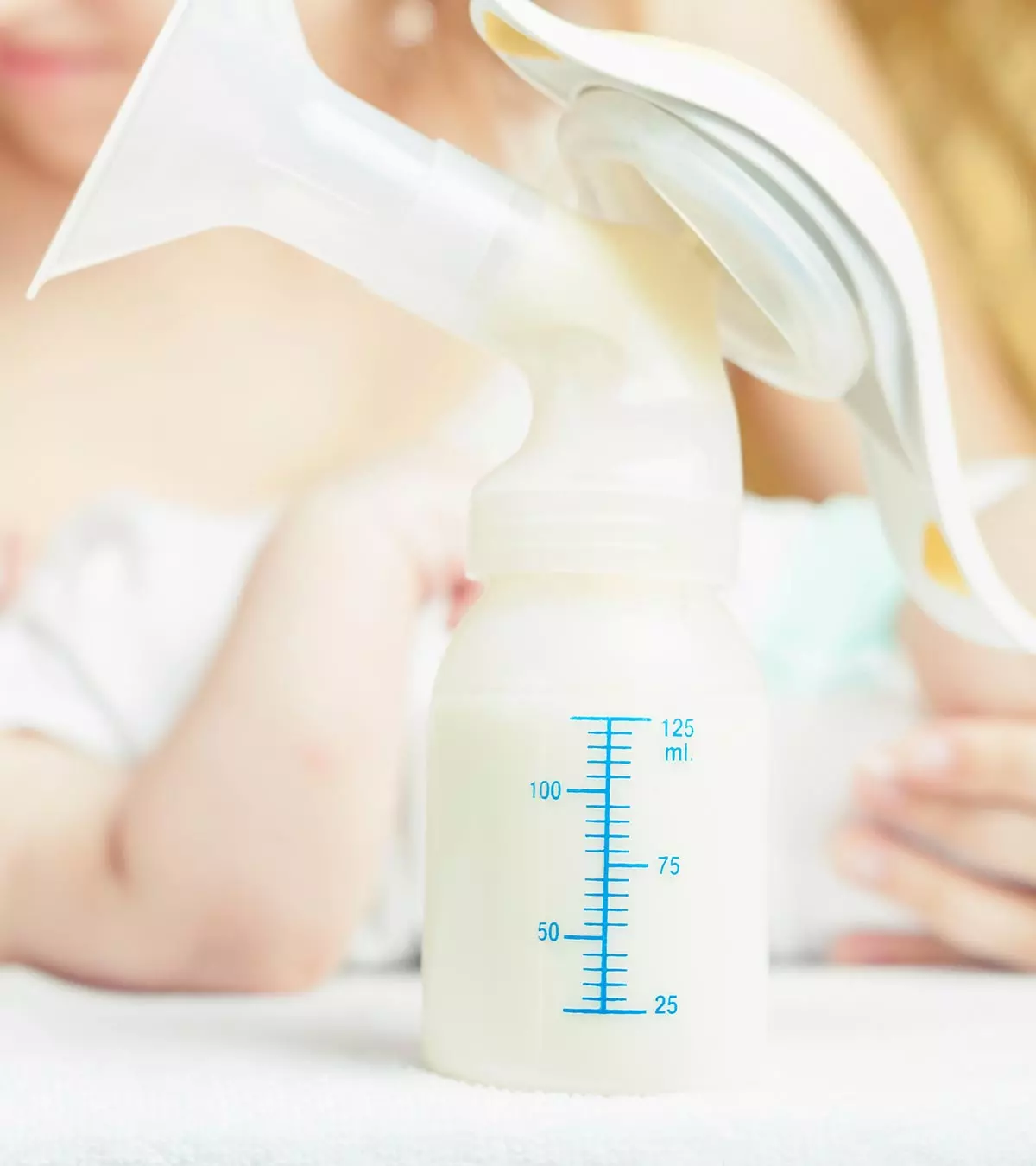

Image: iStock
Bottle-fed babies may encounter the problem of nipple confusion, also known as a bottle preference (1). The natural nipples usually differ from a bottle teat, causing the baby’s two experiences to be different. As a result, the baby may be unable to latch well while breastfeeding (2). The feeding sessions may also become shorter or troublesome, and the baby may always appear hungry. Working mothers using expressed milk or having babies with special needs may experience nipple confusion. However, doctors do not consider it a serious issue but a rather simple one that is easy to resolve. Continue reading this post to understand about nipple confusion, its causes, how breast sucking differs from bottle feeding, and how to deal with the condition.

What Is Nipple Confusion?
A newborn feeds several times in a day, as the mother’s milk is the only thing that the baby can have, and it is easily digestible. Feeding sessions could be long and hard on the mother and she may want to take a break from it. While breast milk is the best, the mother could give her baby expressed (milk which is pumped from the breasts and stored) milk as well. This expressed milk is given in bottles, which have a different make from the breasts. Moving back from a bottle to the breast may cause nipple confusion in the baby. (3)
There is much discussion and debate over the existence of the nipple confusion. The truth is that not all babies suffer from this problem. A lot of doctors and practitioners also do not take heed of this problem. However, it happens as the baby is confused between the mother’s breasts and the bottle teats.
How Is Nipple Confusion Caused?
The way a breast is structured is very different from a bottle, feeder, or pacifier. Giving your baby any of these would confuse the baby as the sucking mechanism is different.
When your baby suckles from a breast, they use about 40 facial muscles to draw milk. The baby should latch on well to the breasts to get a tummy full of milk. When he is sucking from a breast (4):
- The baby’s mouth should be wide open.
- He should have most of the areola (the dark circle near the nipples) in his mouth.
- The baby’s tongue should be forward, below the lower gums, and should be cupped around the nipple.
- The baby then uses his tongue to create negative pressure to get the milk from the breast. If the baby suckles only from the nipple, then he is not getting enough milk.
The above steps indicate a good latch and make sure that the baby gets as much milk as possible. This also ensures that the mother’s breasts are not sore or cracked, which could happen if the baby doesn’t latch on well or tugs too much at the breasts.
When a baby draws milk from a bottle, he need not have to put in a lot of hard work. Bottles and feeders have a hard and tapering nipple, which is easy to suck at. This would mean that they would exert less energy and get more milk.
Once the baby is made to switch back from a bottle to a breast, he may find it difficult to suck and would exert more pressure. As sucking from a bottle is easier, the baby may not want to be breastfed.
Signs Of Nipple Confusion
The most basic nipple confusion signs are the baby rejecting the breasts and abandoning breastfeeding.
- He would stick his tongue out and refuse to suckle at the breasts. Sticking out the tongue will not allow the baby to latch properly.
- If he does not open his mouth wide enough, he would latch on only to the nipple and not the areola. This would mean that he would get less milk.
- The baby could cry and get irritated easily when the mother tries to feed him.
- Schedule changes, like work or other engagements, can also lead to nipple confusion as the mother may not be available to breastfeed her baby.
However, this does not mean that the baby does not wish to be breastfed at all. It only means that he might prefer a bottle to the breasts, as it is easier for him. While this may disappoint the mother, she need not get discouraged as babies can be made to switch back to breastfeeding just as easily.
Do remember that if you have longer gaps between breastfeeding sessions, then the milk supply may be affected.
How To Fix Nipple Confusion
Try these below tips to make your baby love breastfeeding (1) (2)::
1. Do not use pacifiers:
The main problems in nipple confusion are the bottles and pacifiers. The earlier you introduce the bottles, the more confused the baby would be. As bottles are shaped differently, and in a way that they suit the baby’s mouth, babies may be addicted to them. Doctors suggest that you avoid the use of bottles and pacifiers for at least the first six weeks. This would ensure that the baby latches on well to your breasts and drinks only from it. Use bottles and pacifiers only if they are absolutely necessary.
Early use of pacifiers could also give mothers sore nipples as the babies cannot latch on well and hence tug at them. The angle and position, if bad, will also cause nipple cracks.
Using nipple confusion pacifiers means that the babies won’t stay long at the breasts. They could also give them bad oral health and teeth development. (5)
2. Stimulate your breasts:
Your baby may reject your breasts because he doesn’t get adequate milk, leaving him hungry. If you stimulate your breasts before a feeding session, you can ensure sufficient supply of milk. You could even use a breast pump and make sure the baby gets sufficient milk.
3. Talk to a specialist:
Lactation consultant can help you in overcome nipple confusion. They would suggest ways to stimulate more milk, or help the baby latch on well. They could even talk about the problems the baby is facing.
4. Use bottle which is like a breast:
The idea is to avoid bottles, which are shaped differently from a breast. Feeding babies from bottles which are similar to breasts would make them use the same amount of energy and involve the same muscles that they use for breastfeeding. These bottles also have milk flow like the breasts, thereby avoiding milk flow confusion as well.
5. Renew the breastfeeding experience:
Babies respond to stimuli. If you bring your nipple close to your baby’s cheek, she will turn in the direction of the nipple. You could bring the nipple closer to the baby’s lips and let it suckle a while before helping him latch on well. You could also help him latch better by putting your clean pinky finger in his mouth and helping him adjust to the breast. Rebirthing helps a lot of babies, taking a bath together (have another adult to assist) makes baby’s instincts kick in, and might just go for the breast.
6. Show how it is done:
While you may think that your baby is very small to respond to things you say, you’d be surprised at how willing they are to talk to you. We generally talk in a cooing or funny language with babies but talking to them like adults would help. You may have to indulge in a lot more actions, though. Open your mouth and indicate how to latch on to a nipple. Your aim should be to help your baby open his mouth as wide as he can. This should ease the process of exerting energy as well.
Do not force your baby to accept anything, be it pacifiers or breasts. Your baby will learn eventually, and would prefer breasts to bottles if you do not introduce the latter in the first six weeks.
How Real Is Nipple Confusion?
Babies who are premature or suffering from genetic disorders are more likely than the normal babies to face nipple confusion. For most babies, switching between breasts and pacifiers or bottles is easy, and they do not reject one for the other.
Babies have a natural tendency to put anything in their mouth and suck instinctively. This is until they are old enough to pick up things and analyze them.
Nipple confusion could be a major problem when the baby tries to suckle the same way on a nipple as he would on a bottle. As explained earlier, this would draw out lesser and low-calorie milk, making the baby hungry and irritated.
Also, if the mother switches the baby to bottle feeding due to her sore and cracked nipples, the baby may find it difficult to go back to breastfeeding.
Besides these, the baby would not face nipple confusion and could be flexible in switching over.
Can Nipple Confusion Cause Breastfeeding Problems?
Nipple confusion can cause developmental problems only if the baby is feeding neither breast milk nor bottle milk. This could be the case in babies with genetic disorders, but more often than not, babies adapt easily to breastfeeding.
There may be a condition called tongue-tie where the tongue frenulum is too short or tight and does not allow easy suckling. This could prevent the baby from drawing milk.
A colic baby could also face breastfeeding problems resulting in low intake of milk.
You should consult a doctor if your baby is refusing to feed.
What Kind Of Bottles Or Nipples Help Against Nipple Confusion?
A bottle with a nipple which is narrow, and a teat that lets the baby exert some pressure, slow flow would be the best to avoid nipple confusion. These features would make sure that the sucking style is similar to that on a breast.
However, researchers claim that there is no conclusive theory on how nipple confusion can be avoided completely by buying bottles which are shaped like nipples. This is because women have nipples of different shapes and sizes. One common shape of the bottle nipple may not suit all babies.
The shape of the nipple is not as important as the flow of milk. If the flow is too much or too less the baby won’t feed. While buying a bottle, you need to take care that the milk flow is slow and not fast.
Why Would A Mom Switch Over To Bottle Feeding?
There are many reasons as to why a mother would switch to bottle feeding. When we say ‘switch’ we mean only for a couple of feeds a day (6):
- If the mother has an infection which has resulted in a fever, she could have body aches. This means that she might have a problem in breastfeeding as her body would be feeling sore. Although unnecessary, mothers could switch to bottle feeding for a while during this period.
- If the baby has a problem in suckling from the breast, then the mother may switch to bottle feeding as it is easier for the baby.
- A baby that is premature could also be given a bottle at the hospital feed.
- If there is a problem in the mother’s nipple structure, which is rare, could make her switch to a bottle to feed the baby. But could try the nipple shield under the care of a lactation consultant.
- If the mother is a working woman and needs to join back after her maternity break.
When babies who do not feed well are given bottles, they may reject the breasts as bottles are easier to drink from. In such cases, nipple confusion becomes more of a preference of feeding than confusion per se.
Is Bottle-Feeding Easier Than Nipple Feeding?
Sucking milk from a bottle is aided by many things, including gravity. When a baby sucks from a bottle, the long nipple helps him draw out milk easily. Gravity helps as the bottle is tilted. As the bottle is full, and comes in certain measurements, it makes it easy for the baby to suck little and draw more milk.
The baby need not have to spend a lot of energy or co-ordinate his tongue and lips to suck milk from a bottle. The mere use of lips helps draw milk out. The tongue can only be used to stop the milk flow. This is the reason baby prefers bottle to breastfeeding.
One thing to keep in mind is that if your baby is drinking from a bottle, he should not make a lot of sucking noises and not empty the battle too quick. If he is doing this, then he is taking in more air than milk and the nipple might be too fast. Hold the baby at an angle of 45º to prevent this.
Why Is Breastfeeding Better Than Bottle Feeding?
There is no one answer to this. While in some cases it is may be fine to bottlefeed a baby, as the mother or baby could be facing certain issues, breastfeeding is always the best option.
The mother may be using expressed milk to bottle feed the baby, but direct breastfeeding has more advantages than just giving the right nourishment.
- The baby experiences personal touch, which makes them feel safe. Studies prove that a mother’s touch improves a baby’s health and makes them feel secure. (7) The skin-to-skin contact aids in the baby’s overall development.
- Unlike in a bottle, the milk is regulated when breastfed. The baby has access not just to the low-calorie (foremilk) milk but also the high-calorie (hindmilk). The baby knows when to stop and moves away once the tummy is full.
- The baby does not suckle more air as could be the case with bottle feed, and gets fresh milk instead of any stored milk.
- The baby’s oral muscles develop well when he suckles from a breast. The baby’s heart rate, body temperature, and respirations are also stable due to the mother’s contact.
Nipple confusion is not a common problem as suckling mother’s breasts comes naturally for the baby. Make him feel comfortable by placing him in a convenient position while breastfeeding. Have patience and support him if he is finding it difficult to locate your nipple or latch on to it. Do check with your doctor if your baby is unable to drink breast milk in spite of your best efforts.
Frequently Asked Questions
1. Can expressed milk confuse a baby?
Expressed milk does not confuse the baby if you give it in bottles whose nipples are shaped like yours. Confusion in the baby arises from the shape of the feeder and not the milk. Expressed milk is always better than formula.
2. Are there any risks involved in nipple confusion?
There are no known risks involved in nipple confusion. The baby may have developmental issues, but only if he does not feed at all.
3. How are the muscle movements different when the baby is breastfeeding?
The facial movements and muscles involved in breastfeeding are complex and different from bottle feeding. The sucking motion is like a wave with the nipple almost touching the roof of the baby’s mouth. Sucking from the breasts improves the baby’s jaw structure, maintains the teeth alignment, and could also keep the airway passage clear, preventing snoring or asthma.
Nipple confusion is when a baby has difficulty switching between feeding bottles and breastfeeding. They may not latch well for breastfeeding after being bottle-fed or unable to bottle feed after being fed from the breasts. This issue is often encountered when expressed breast milk is fed when the mother cannot breastfeed on certain feeding sections. Moreover, babies can get irritated and fussy due to nipple confusion. However, using bottles with nipples like breasts and training could improve this issue. You may seek advice and training from a lactation consultant to get more personalized solutions.
References
- Nipple Confusion.
https://llli.org/breastfeeding-info/nipple-confusion/ - Nipple Confusion.
https://www.laleche.org.uk/nipple-confusion/ - E Zimmerman and K Thompson; (2015); Clarifying nipple confusion.
https://pubmed.ncbi.nlm.nih.gov/26181720/ - Getting a good latch.
https://womenshealth.gov/breastfeeding/learning-breastfeed/getting-good-latch - Breastfeeding: 6 Things Nursing Moms Should Know About Dental Health.
https://www.mouthhealthy.org/all-topics-a-z/breastfeeding/ - Should I breastfeed or bottle-feed my baby?.
https://babyschool.yale.edu/should-i-breastfeed-or-bottle-feed-my-baby/ - Jeannette Crenshaw; (2007); Care Practice #6: No Separation of Mother and Baby With Unlimited Opportunities for Breastfeeding.
https://www.ncbi.nlm.nih.gov/pmc/articles/PMC1948089/
Community Experiences
Join the conversation and become a part of our nurturing community! Share your stories, experiences, and insights to connect with fellow parents.
Read full bio of Rebecca Koyf
Read full bio of Swati Patwal














